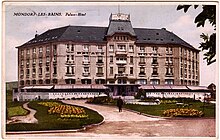WWII Allied prisoner-of-war camp in Luxembourg
The "class of 45": Prisoners of Ashcan posing for a group photo in August 1945. In the center of the bottom row, Hermann Göring . Central Continental Prisoner of War Enclosure No. 32 , code-named Ashcan Allied prisoner-of-war camp in the Palace Hotel of Mondorf-les-Bains , Luxembourg during World War II . Operating from May to August 1945, it served as a processing station and interrogation center for the 86 most prominent surviving Nazi leaders prior to their trial in Nuremberg , including Hermann Göring and Karl Dönitz .
A British counterpart of Ashcan , Camp Dustbin in Castle Kransberg near Frankfurt am Main , housed prisoners of a more technical inclination including Albert Speer and Wernher von Braun .
History
The Palace Hotel before the war. The camp was established by order of Allied Command.[ 1] Burton C. Andrus , and staffed by men of the U.S. 391st Anti-Aircraft Battalion ,[ 2] [ 3]
The place selected for the camp was the Palace Hotel, a four-story luxury hotel dominating the small spa town, which had earlier in 1945 been used as a billet for U.S. troops.[ 1] klieg lights .[ 4] MPs guarding the perimeter knew not what went on inside; they quipped that getting in required "a pass signed by God, and then somebody has to verify the signature".[ 2] [ 3]
On 10 August 1945, the prisoners were transferred to Nuremberg to stand trial, and the camp was disbanded shortly afterwards. The building continued to serve as a hotel until 1988, when it was demolished to make way for a more modern spa .
Prisoners
Prisoners at Ashcan included most of the defendants in the Nuremberg Trials along with many other senior Nazi Party, government and military officials.
Nuremberg trials defendants
The following were brought to trial by the International Military Tribunal at the Nuremberg trials of November 1945 to October 1946.
Reichsmarschall Hermann Göring , President of the Reichstag Commander-in-Chief of the Luftwaffe and Reichsminister Aviation Großadmiral Karl Dönitz , Reichspräsident Commander-in-Chief of the Kriegsmarine Generalfeldmarschall Wilhelm Keitel , Chief of Staff of the Oberkommando der Wehrmacht Generaloberst Alfred Jodl , Chief of Operations of the Oberkommando der Wehrmacht SS-Obergruppenführer Ernst Kaltenbrunner , Chief of the Reich Security Main Office Franz von Papen , Vice-Chancellor Joachim von Ribbentrop , Reichsminister Wilhelm Frick , Reichsminister of the Interior , Reichsleiter Reich Protector of Bohemia-Moravia Walther Funk , Reichsminister of Economics and President of the Reichsbank Alfred Rosenberg , Reichsminister for the Occupied Eastern Territories and Reichsleiter Albert Speer , Reichsminister of Armaments and War Production Robert Ley , Reichsorganisationsleiter , Reichsleiter and head of the German Labour Front Fritz Sauckel , General Plenipotentiary for Labour Deployment, Gauleiter Reichsstatthalter Thuringia Hans Frank , General Governor of Poland and Reichsleiter Arthur Seyß-Inquart , Reichskommissar Netherlands Julius Streicher , Gauleiter of Franconia and publisher of Der Stürmer
Subsequent Nuremberg trials defendants
The following were brought to trial in the subsequent Nuremberg trials between December 1946 and October 1948.
Johann Ludwig Graf Schwerin von Krosigk , Reichsminister of Finance and Chief Minister of the Flensburg government Richard Walther Darré , Reichsminister of Food and Agriculture and Reichsleiter Hans Lammers , Reichsminister and Head of the Reich ChancelleryOtto Meissner , Staatsminister Wilhelm Stuckart , Staatssekretär Reichsminister of the Interior Gustav Adolf Steengracht von Moyland , Staatssekretär in the Foreign MinistryErnst Wilhelm Bohle , Gauleiter for the Nazi Party/Foreign Organization Karl Brandt , Reichskommissar for Sanitation and Health and co-head of the Aktion T4 euthanasia programGeneraloberst Johannes Blaskowitz , Commander-in-Chief of Army Group G and Army Group H General der Artillerie Walter Warlimont , Deputy Chief of Operations of the Oberkommando der Wehrmacht General der Infanterie Hermann Reinecke , Chief of the General Office of the Oberkommando der Wehrmacht
Others
Other prisoners included:
Franz Seldte , Reichsminister of LaborFriedrich Wilhelm Kritzinger , Staatssekretär and Deputy Chief of the Reich ChancelleryHans-Joachim Riecke , Staatssekretär in the Ministry of Food and AgricultureWerner Zschintzsch , Staatssekretär in the Reich Ministry of Science, Education and Culture Jakob Nagel [de ] Staatssekretär in the Reich Postal Ministry Kurt Daluege , Chief of the Ordnungspolizei Walter Buch , Reichsleiter and Chief of the Supreme Party Court Franz Xaver Schwarz , Reichsleiter and National Treasurer of the Nazi PartyFranz Ritter von Epp , Reichsleiter and Reichsstatthalter (Reich Governor) of Bavaria Paul Wegener , Gauleiter of Gau Weser-Ems and Reichsstatthalter of Bremen and Oldenburg Erwin Kraus [de ] , Korpsführer National Socialist Motor Corps Philipp, Landgrave of Hesse , Oberpräsident Province of Hesse-Nassau Karl Strölin , Oberbürgermeister Stuttgart Generalfeldmarschall Gerd von Rundstedt , Commander-in-Chief in the West Generalfeldmarschall Albert Kesselring , Commander-in-Chief in the South Generaloberst Georg Lindemann , Commander-in-Chief in Denmark Vizeadmiral Leopold Bürkner , Abwehr Konteradmiral Gerhard Wagner , Chief of Naval Operations and Chief of the Military Cabinet of the Flensburg governmentAdmiral Miklós Horthy , Regent of the Kingdom of Hungary Albert Göring , brother of Hermann Göring, later released without charges
^ a b Dolibois, 86 .
^ a b Dolibois, 85 .
^ a b Dolibois, 87 .
^ Dolibois, 84 .
References
External links
49°30′18″N 6°16′48″E / 49.5050°N 6.2800°E / 49.5050; 6.2800

